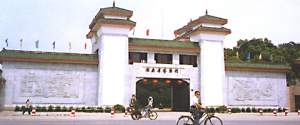www.hnmuseum.com
 |
The Hunan Provincial Museum is situated in the northeast of Changsha City. Built in 1951 and opened to visitors in 1956, the Museum covers an area of 50,000 square meters with a construction area of 20,000 square meters.
The Museum contains a collection of more than 110,000 objects, including 763 pieces of the first grade. Its exhibits consist of stone implements of the Neolithic Age, potteries, bronze wares of the Shang and Zhou periods (17th century -256 BC), relics from the Chu State and relics from a big tome excavated in 1972 -- Mawangdui Western Han (206 BC-8 AD) Tomb. Besides, Yuezhou celadon produced from the Eastern Han (25-220) to the Tang (618-907) period, Changsha Tang San Cai (Tri-color Glazed Porcelain of the Tang Dynasty), the facsimiles of Wang Xizhi'sPrologue to the Orchid Pavilion Collectionand the handwriting of Wang Fuzhi, the great thinker of the early Qing period (1644-1911), are also housed here.
The Museum features two basic displays, namely, the Display of Historical Relics of Hunan and the Display of Mawangdui Han Tomb. Among all these collections, the relics from Mawangdui Han Tomb about 2000 years ago are most excellent and miraculous. The tomb and corpse of Xin Zhui, Marquise of Dai, was surprisingly well preserved and in remarkable condition, from skin to inner organs. Among the more than 3,000 relics unearthed, were exquisite lacquer wares, musical instruments, silk paintings, pottery and Chinese medicinal herbs. All of the artifacts placed in the grave as well as the corpse, swaddled in 20 layers of silk and linen can be found on display.
One of the most fascinating finds from the tomb is a T-shaped silk picture found in the Mawangdui No.1 Han Tomb, supposedly a banner for the soul. It is in extremely good condition and describes the voyage from the dead to the next world. The painting techniques and the color are of the highest quality. Twenty-eight long-lost ancient silk books were unearthed in the Mawangdui No.3 Han Tomb, most of which are of great medicinal, astronomical, philosophical and historical values.
Forty-nine changes of clothes were retrieved from Xin Zhui's tomb, most of them impeccably preserved, and represent perhaps the most spectacular of the tomb's many treasures. Among the fabrics are pearl-white ramie, loosely woven hemp, and brushed cotton -- not to mention an impressive array of silks. Verdant silk shoes, silk gloves embroidered with migrant birds, and a transparent gauze silk robe are only a few objects found in the Marquise's armoire. Even more impressive are the silk garments decorated with exquisite raised-thread brocade designs. Larger cross-shaped funerary banners display an entire theatrical scene, and offer insights into the complex social, political, and cosmological worlds of early Han Dynasty culture.
In addition to the annual exhibitions, the Museum often organizes temporary exhibitions on special topics at home and abroad, such as the Exhibition of Hunan Revolutionary History, the Exhibition of Chu Cultural Relics, the Exhibition of Paintings of the Ming and Qing Dynasties Collected by the Museum, the Exhibition of Crafts of the Ming and Qing Dynasties, and the Exhibition of Painting Collection of Qi Baishi, etc.
Publications of the Museum includethe Hunan Provincial Museum,Changsha Mawangdui No.1 Han Tomb,Research on Mawangdui Han Tomb, andArcheological Volume of Hunan.